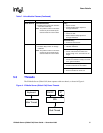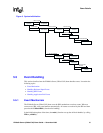
IP Media Server (Global Call) Demo Guide — November 2003 45
platforms provide an SCbus interface for interconnection of multiple DM3 platforms, or connection to other SCSA-
compatible hardware. The DM3 platform supports timeslot bundling for high bandwidth, and can access up to 256
of the 2048 SCbus timeslots via two SC4000 ASICs.
SIP: Session Initiation Protocol: an Internet standard specified by the Internet Engineering Task Force (IETF) in
RFC 2543. SIP is used to initiate, manage, and terminate interactive sessions between one or more users on the
Internet.
T1: A digital transmission link with a capacity of 1.544 Mbps used in North America. Typically channeled into 24
digital subscriber level zeros (DS0s), each capable of carrying a single voice conversation or data stream. T1 uses
two pairs of twisted pair wires.
TCP: see Transmission Control Protocol
Terminal: An H.323 Terminal is an endpoint on the local area network which provides for real-time, two-way
communications with another H.323 terminal, Gateway, or Multipoint Control Unit. This communication consists
of control, indications, audio, moving color video pictures, and/or data between the two terminals. A terminal may
provide speech only, speech and data, speech and video, or speech, data, and video.
Transmission Control Protocol: The TCP/IP standard transport level protocol that provides the reliable, full
duplex, stream service on which many application protocols depend. TCP allows a process on one machine to send
a stream of data to a process on another. It is connection-oriented in the sense that before transmitting data,
participants must establish a connection.
UDP: see User Datagram Protocol
UDPTL: Facsimile UDP Transport Layer protocol
User Datagram Protocol: The TCP/IP standard protocol that allows an application program on one machine to
send a datagram to an application program on another machine. Conceptually, the important difference between
UDP datagrams and IP datagrams is that UDP includes a protocol port number, allowing the sender to distinguish
among multiple destinations on the remote machine.
VAD: Voice Activity Detection


















